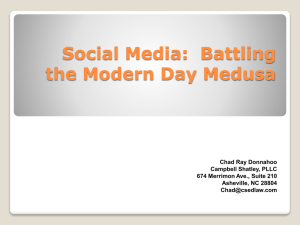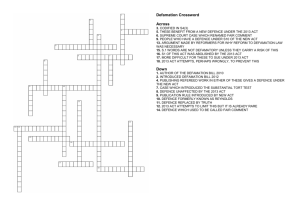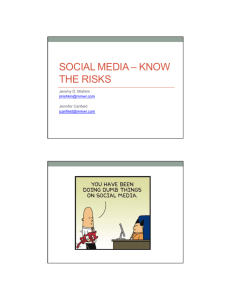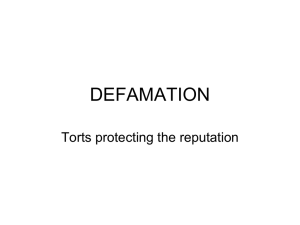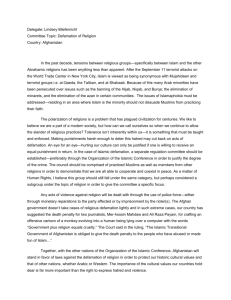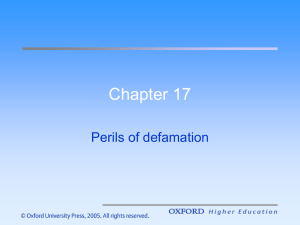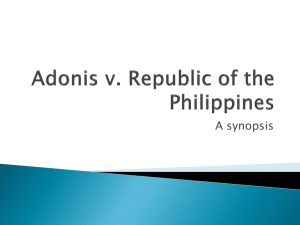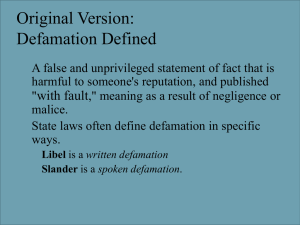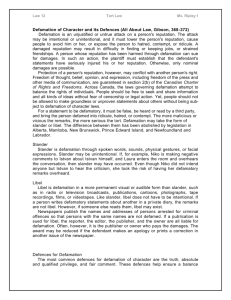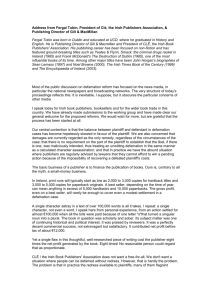DEFAMATION IN VICTORIA - Environmental Justice Australia
advertisement
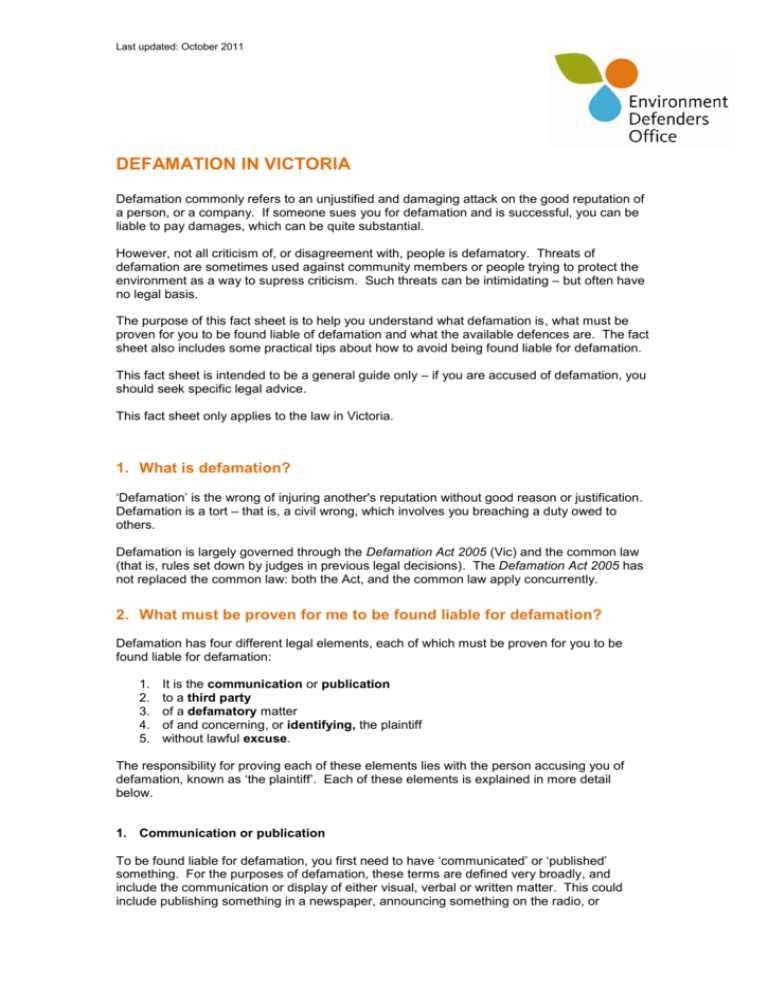
Last updated: October 2011 DEFAMATION IN VICTORIA Defamation commonly refers to an unjustified and damaging attack on the good reputation of a person, or a company. If someone sues you for defamation and is successful, you can be liable to pay damages, which can be quite substantial. However, not all criticism of, or disagreement with, people is defamatory. Threats of defamation are sometimes used against community members or people trying to protect the environment as a way to supress criticism. Such threats can be intimidating – but often have no legal basis. The purpose of this fact sheet is to help you understand what defamation is, what must be proven for you to be found liable of defamation and what the available defences are. The fact sheet also includes some practical tips about how to avoid being found liable for defamation. This fact sheet is intended to be a general guide only – if you are accused of defamation, you should seek specific legal advice. This fact sheet only applies to the law in Victoria. 1. What is defamation? ‘Defamation’ is the wrong of injuring another's reputation without good reason or justification. Defamation is a tort – that is, a civil wrong, which involves you breaching a duty owed to others. Defamation is largely governed through the Defamation Act 2005 (Vic) and the common law (that is, rules set down by judges in previous legal decisions). The Defamation Act 2005 has not replaced the common law: both the Act, and the common law apply concurrently. 2. What must be proven for me to be found liable for defamation? Defamation has four different legal elements, each of which must be proven for you to be found liable for defamation: 1. 2. 3. 4. 5. It is the communication or publication to a third party of a defamatory matter of and concerning, or identifying, the plaintiff without lawful excuse. The responsibility for proving each of these elements lies with the person accusing you of defamation, known as ‘the plaintiff’. Each of these elements is explained in more detail below. 1. Communication or publication To be found liable for defamation, you first need to have ‘communicated’ or ‘published’ something. For the purposes of defamation, these terms are defined very broadly, and include the communication or display of either visual, verbal or written matter. This could include publishing something in a newspaper, announcing something on the radio, or Last updated: October 2011 displaying something on a sign. This also includes emails, or publications on a website: cyber-defamation is discussed in more detail below. 2. To a third party The communication or publication must be to a third party – that is, someone other than the person who claims they have been defamed. Communication only to the person defamed is not enough. However, communication to just one person other than the person allegedly defamed is sufficient in proving this element of defamation. 3. Of a defamatory matter Once it has been established that there has been a communication to a third party, the key question in most cases concerning defamation is whether that communication was of a ‘defamatory matter’. A ‘defamatory matter’ may be a blatant and obvious lie about a person. However it also includes a false representation, also known as an ‘imputation’. An opinion, even a critical opinion, is not necessarily a defamatory matter. A matter is considered to be defamatory if the plaintiff can prove that their reputation has been damaged by the publication of the defamatory matter. Importantly, to prove this the plaintiff must show that they have a reputation to be damaged in the place where the matter was published (this will usually be the plaintiff’s usual place of residence, or their place of employment). For example, if you publish something negative about someone in Russia, where that person is not known, you will not have committed defamation because that person has no reputation in Russia. Damage to reputation is proven by showing that the publication has harmed or lowered the plaintiff’s reputation in the eyes of ordinary reasonable people in the community in general. This is the objective test utilised by courts in assessing damage. To avoid publishing defamatory matters, it is usually best to keep your publications confined to truth or opinion that can be justified through proper material. Allegations of the guilt of another person for a crime or wrong must be able to be justified and supported by facts. For example, if you say a person is under the suspicion of guilt then this is allowed, so long as it is in fact justifiable. Going beyond this through innuendo will amount to defamation. 4. Identifying the plaintiff For a publication to be defamation, the defamatory matter must identify the plaintiff. Identification can be by name, but also by title or other sufficient information that a reasonable person would associate with the plaintiff. The existence of identifiers in a publication that may reasonably identify the plaintiff will be sufficient in proving this element of defamation. For example, publishing a defamatory matter about the Chief Executive Officer of X Company would be sufficient to identify that person. A group cannot be defamed, only individuals. 1 Most corporations cannot sue for defamation under the uniform defamation legislation. The exceptions to this are non-profit corporations and corporations with less than ten employees 1 Note that corporations may be able to sue under other causes of action such as injurious falsehood if you publish something untrue about them. They may even sue you in negligence, which is slightly farfetched as it assumes the existence of a prior relationship, in which you (the defendant) failed to exercise reasonable care by publishing defamatory content. This is very hard to prove and judicially undesired. Last updated: October 2011 2 that are not related to another corporation. A government body, such as a local Council, cannot sue for defamation. Persons within corporations or public/government bodies may still sue as individuals of the corporation or government body if they are defamed in a publication, even if the corporation or government body is also defamed in the same article. 5. Without lawful excuse Even if all the above elements are proven, you cannot be found liable of defamation if you have a ‘lawful excuse’. Some, but not all, of the available lawful excuses are set out under the heading ‘Defences’, below. 3. Who can be sued? Everyone who participates in authorises or repeats the negligent or intentional publication of defamatory matter is liable in the first instance for defamation. This is subject to defences. 4. Defences Even if a plaintiff can show that the material published was defamatory, if one of the defences discussed below apply, you will not be liable in defamation. Other defences are available, but those listed in this fact sheet are the most relevant. 1. Opinion Statements that are not stated as fact may be published as opinion. The opinion needs to be 3 on a matter of public interest and based on proper material . The comment must be a matter of opinion, criticism, observation or conclusion. The facts on which the comment is based must be stated, in order to satisfy the ‘proper material’ element of this defence. The opinion must also be honestly held. Previously published opinion may have a bearing on whether someone can rely on this defence. Ultimately, commentary based on facts is allowed, however the positing of defamatory statements is prohibited. 2. Truth As noted earlier, you can say, write or display whatever you like, so long as it is true. For this 4 defence to apply, you must prove that what you have published is substantially true. Use of the word ‘substantial’ suggests that if the publication is mostly true, then this is enough to raise this defence. First-hand proof is required in establishing this defence. There is no requirement to prove publication in the public interest for this defence. 3. Contextual Truth It is a defence to a claim of defamation if you have published a defamatory matter amongst 5 one or more other matters that can be shown to be substantially true. This defence only 2 Defamation Act 2005 s 9. Defamation Act 2005 s 31. 4 Defamation Act 2005 s 25. 5 Defamation Act 2005 s 26. 3 Last updated: October 2011 applies if you can show that because of the substantially true comments, the reputation of the plaintiff has not been further harmed. 4. Qualified Privilege This defence is used if you, as the defendant, have a legal, social or moral obligation to communicate something to a third party. An example is the provision of employment references. The relationship between the defendant and the recipient of this type of communication is important; they must have an interest in the communication, because communication to just anybody is not protected. Discussion of political and government matters may also be covered by the defence of qualified privilege, although in this case you should take steps to ensure the statements you make are true before making them. You can only rely on this defence if the statements you make are reasonable, and not malicious. 6. Absolute Privilege Those things published during parliamentary debates or in a court or tribunal judgment are privileged and can be published with immunity. 7. Public Document Matter contained in public documents can also be published without risk of being defamatory. Public documents are those published by Parliament, governments, courts and tribunals. 8. Fair Report A fair report of any proceedings of public concern is a defence to a charge for defamation. It is also a defence defamation if the defendant can show that the matter was contained in a report published earlier on a proceeding of public concern and has been utilised by the defendant in a fair summary. 9. Innocent dissemination This defence applies to people who distribute publications, but who have no control over the publications’ content. It typically applies to mechanical distributors or conduits, such as internet service providers. 10. Triviality If the publication of defamatory can be shown to be unlikely to cause the person substantial harm, the defence of triviality will apply. 5. If someone wants to sue me for defamation, when must they do it by? For material published after the uniform defamation legislation was enacted on 1 January 2006, if a person wants to sue you for defamation, they must do commence their action within one year of the publication of the defamatory material. If this one year time limit has been missed, extensions are available up to a period of 3 years from the date of publication. For the extension, a plaintiff must show that it was not reasonable for him/her to commence proceedings within the allowable twelve months. Last updated: October 2011 6. Multiple publication rule Defamation is based on the multiple publication rule, which states that each time there is a communication or publication of defamatory matter, it gives rise to a new cause of action. This has implications for the limitation period for publications on websites, because cached defamatory content and even archived content will re-ignite a limitation period if it is downloaded in a place where the plaintiff has a reputation. 7. Cyber-defamation Everyone who participates in authorises or repeats the negligent or intentional publication of defamatory matter is potentially liable for defamation. Liability may also arise by omissions, so the failure to remove defamatory content, where you have the power to do so, means could be are liable for defamation. For example, the failure to remove online or physical posting of defamatory content from a website you manage means you are a publisher for the purposes of defamation law and could be liable for publication. Liability is not confined to original authors. Publishers and printers are liable as well as original authors, but only if they disseminate the publication. If they merely print out the publication and return it to the original author, then they are not liable. Linking to defamatory content If you provide a link to defamatory content, you may be liable for publication. However, if you are not the original author and merely innocently or accidentally pass on the content and have not exercised any editorial control over the content, then the defence of ‘innocent dissemination’ may save you (discussed above). However, if you are aware of the defamatory content and your link to it indicates your awareness, then your involvement in publication will not be considered to be innocent dissemination. 6 Internet service providers and internet hosts are logically exempt from liability for defamatory publications, provided the providers lacked knowledge of the defamatory nature of the publication. The innocent dissemination defence generally applies to the makers of systems, carriage providers or broadcasters of live programs who do not exercise control over the content and generally do not have knowledge of the defamation. E-mails and defamation For the purposes of defamation law, e-mails are no different to other modes of publication: in fact it increases the variety of publication, making them visual, audio visual, or spoken. An image or representation of a person, transmitted through e-mail, still amounts to a publication. Those publishing and those authorising, for example, employers who provide facilities for the sending and receipt of e-mails will be liable for publication, if no defence exists. Some general information on cyber defamation 6 The Broadcasting Services Act does not really provide a definition of content host but it is generally assumed that the term refers to services that allow other people to put their content online through a provision of some carrier service. Therefore this defence does not save operators of websites and those exercising editorial control over their content. Last updated: October 2011 Cyber defamation, like other types of defamation, does not occur until defamatory matter is communicated or published. Publication for online content does not occur until this content is 7 downloaded. Until content is downloaded in a place where the plaintiff has a reputation, there is no defamation, despite the global and persistent availability of cyber content. The Victorian Supreme Court Rules allow for service outside the jurisdiction (to an international defendant) if Victoria is the place where the plaintiff has a reputation and it has been damaged by an international defendant, through publication on its website or other medium. The location where a website is hosted does not have a bearing on the jurisdiction of a claim. This means that a plaintiff is able to sue in any Australian state (or even internationally) where cyber content is downloaded, so long as the plaintiff also has a reputation in this location. If the plaintiff does not have a reputation in the location where defamatory matter is published or downloaded, then there is no damage to reputation. 8. Some practical tips to avoid being found liable for defamation It is important to remember that plaintiffs can only sue in places where they have a reputation. So if publication occurs in a place where they do not have a reputation, then there are no grounds for an action. However for cyber publications, if the content is downloaded in a place where the plaintiff has a reputation, then s/he will be able to commence proceedings. You can always reduce your potential liability and save yourself some legal fees by deleting, retracting and/or apologising for the publication of defamatory content. Even if you have not identified the person being defamed, before you publish consider whether there is something within your publication that may still identify this person. It is also important to remember that it is not merely your communications with media outlets that may give rise to a defamation claim. It is publication to any third party and if the plaintiff gains awareness of him/her being the subject of these defamatory statements, then s/he may choose to sue. Of course this is tied in with reputation, so if you verbally defame a plaintiff overseas and s/he has no reputation there, then no defamation will have occurred. 9. Where can I get more information? If you require specific legal advice about defamation you could contact: The Environment Defenders Office (Victoria) Ltd: The Environment Defenders Office is a Community Legal Centre that can provide legal advice and sometimes representation in matters which may have a significant impact on the environment or where the matter raises important issues of public policy or with respect to the operation of environmental laws. Phone: 8341 3100 (metropolitan) or 1300 336 842 (regional) Website: www.edovic.org.au 7 Dow Jones Company Inv v Gutnick [2001] VSCA 249. Last updated: October 2011 Victoria Legal Aid: Victoria Legal Aid is a state-wide organization that can provide legal assistance to socially and economically disadvantaged people in Victoria. Phone: 9269 0120 or 1800 677 402 Website: www.legalaid.vic.gov.au Community Legal Centres: Community Legal Centres are independent community organisations that provide legal advice to the public, particularly for those facing economic and social disadvantage. Victoria has 49 Community Legal Centres based all around the State. To find your nearest Community Legal Centre, contact the Federation of Legal Centres. Phone: 9652 1500 Website: www.communitylaw.org.au Last updated: October 2011 ABOUT THE ENVIRONMENT DEFENDERS OFFICE (VICTORIA) LTD The Environment Defenders Office (Victoria) Ltd (EDO) is a Community Legal Centre specialising in public interest environmental law. Our mission is to support, empower and advocate for individuals and groups in Victoria who want to use the law and legal system to protect the environment. We are dedicated to a community that values and protects a healthy environment and support this vision through the provision of information, advocacy and advice. In addition to Victorian-based activities, the EDO is a member of a national network of EDOs working to protect Australia‟s environment through environmental law. If you have a query about anything in this Fact Sheet, or would like the Environment Defenders Office to assist you to protect the environment, please call us: 8341 3100 (metropolitan) or 1300 336 842 (regional) To learn more about the EDO – who we are and what we do – please visit our website: www.edovic.org.au DISCLAIMER While all care has been taken in preparing the information on this fact sheet, it is not a substitute for legal advice. For any specific questions seek legal advice. The Environment Defenders Office accepts no responsibility for any loss or damage suffered by people relying on the information on this fact sheet.
